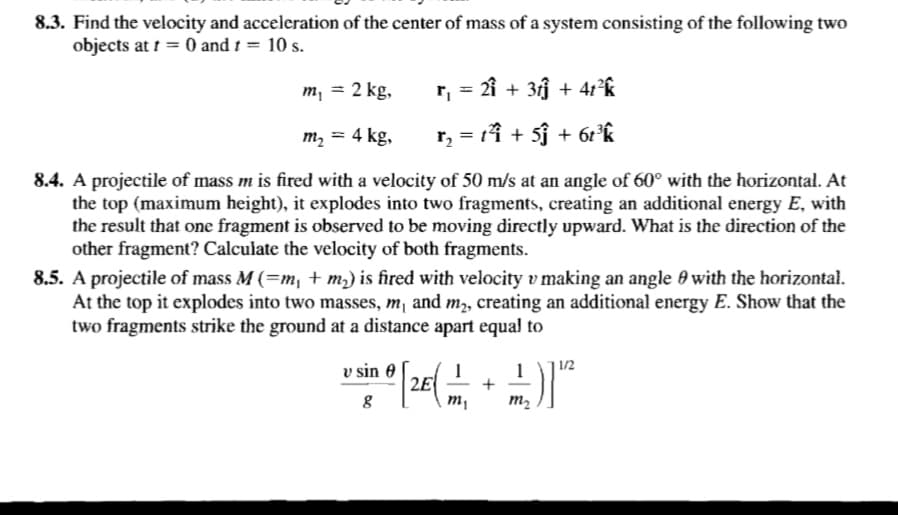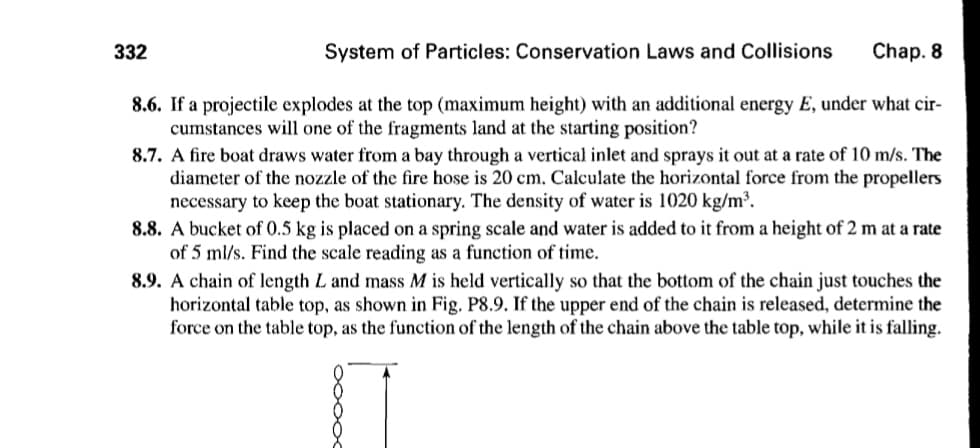8.3. Find the velocity and acceleration of the center of mass of a system consisting of the following two objects at t = 0 and 1 = 10 s. m, = 2 kg, r, = 28 + 3j + 41°k m, = 4 kg, r, = ri + sj + 6rk
8.3. Find the velocity and acceleration of the center of mass of a system consisting of the following two objects at t = 0 and 1 = 10 s. m, = 2 kg, r, = 28 + 3j + 41°k m, = 4 kg, r, = ri + sj + 6rk
Principles of Heat Transfer (Activate Learning with these NEW titles from Engineering!)
8th Edition
ISBN:9781305387102
Author:Kreith, Frank; Manglik, Raj M.
Publisher:Kreith, Frank; Manglik, Raj M.
Chapter6: Forced Convection Over Exterior Surfaces
Section: Chapter Questions
Problem 6.34P
Related questions
Question
Number 8.7 and 8.8 please and 8.3

Transcribed Image Text:8.3. Find the velocity and acceleration of the center of mass of a system consisting of the following two
objects at t = 0 and 1 = 10 s.
m, = 2 kg,
r, = 2î + 3j + 41°k
m, = 4 kg,
r, = 11 + 5j + 62°k
%3D
8.4. A projectile of mass m is fired with a velocity of 50 m/s at an angle of 60° with the horizontal. At
the top (maximum height), it explodes into two fragments, creating an additional energy E, with
the result that one fragment is observed to be moving directly upward. What is the direction of the
other fragment? Calculate the velocity of both fragments.
8.5. A projectile of mass M (=m, + m2) is fired with velocity v making an angle 0 with the horizontal.
At the top it explodes into two masses, m, and m,, creating an additional energy E. Show that the
two fragments strike the ground at a distance apart equal to
v sin 0
1
+
| 1/2
m,
m2

Transcribed Image Text:332
System of Particles: Conservation Laws and Collisions
Chap. 8
8.6. If a projectile explodes at the top (maximum height) with an additional energy E, under what cir-
cumstances will one of the fragments land at the starting position?
8.7. A fire boat draws water from a bay through a vertical inlet and sprays it out at a rate of 10 m/s. The
diameter of the nozzle of the fire hose is 20 cm. Calculate the horizontal force from the propellers
necessary to keep the boat stationary. The density of water is 1020 kg/m³.
8.8. A bucket of 0.5 kg is placed on a spring scale and water is added to it from a height of 2 m at a rate
of 5 ml/s. Find the scale reading as a function of time.
8.9. A chain of length L and mass M is held vertically so that the bottom of the chain just touches the
horizontal table top, as shown in Fig. P8.9. If the upper end of the chain is released, determine the
force on the table top, as the function of the length of the chain above the table top, while it is falling.
Expert Solution
This question has been solved!
Explore an expertly crafted, step-by-step solution for a thorough understanding of key concepts.
Step by step
Solved in 2 steps

Knowledge Booster
Learn more about
Need a deep-dive on the concept behind this application? Look no further. Learn more about this topic, mechanical-engineering and related others by exploring similar questions and additional content below.Recommended textbooks for you

Principles of Heat Transfer (Activate Learning wi…
Mechanical Engineering
ISBN:
9781305387102
Author:
Kreith, Frank; Manglik, Raj M.
Publisher:
Cengage Learning

Principles of Heat Transfer (Activate Learning wi…
Mechanical Engineering
ISBN:
9781305387102
Author:
Kreith, Frank; Manglik, Raj M.
Publisher:
Cengage Learning